Pickle juice, Russia
Not surprisingly, Russians have a lot of great hangover cures. One of the favourites is chugging a glassful of the brine out of a jar of pickled gherkins. Apparently, the fermentation process creates digestive probiotics and the salt helps replace lost electrolytes.
You can buy a big jar of Uncle Vanya-brand gherkins at Sedmoi Kontinentsupermarkets all over Russia for 80 roubles (about £1 and falling). Better still, take your own mug along to one of the babushkas selling pickled cucumbers from barrels in the farmers’ market. Pickling things is a passion in Russia and involves salt, peppercorns, garlic cloves, dill and a dacha-load of magic optional extras, such as horseradish and blackcurrant leaves.
Where to find it in the UK
There’s nothing to stop you glugging gherkin juice at home, but it’s worth noting that “picklebacks” (whisky followed by a shot of pickling brine) have become trendy in London bars. Pitt Cue Co in Soho, where a pickleback is £4.50, makes its own pickle juice with cider vinegar, demerara sugar and aromatics such as fennel and mustard. The addition of star anise can help clear the head and soothe the stomach.
Phoebe Taplin
There’s nothing to stop you glugging gherkin juice at home, but it’s worth noting that “picklebacks” (whisky followed by a shot of pickling brine) have become trendy in London bars. Pitt Cue Co in Soho, where a pickleback is £4.50, makes its own pickle juice with cider vinegar, demerara sugar and aromatics such as fennel and mustard. The addition of star anise can help clear the head and soothe the stomach.
Phoebe Taplin
Pancita (tripe stew), Mexico
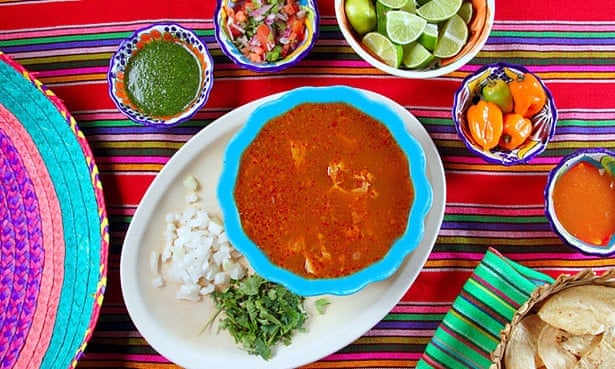
Let’s face it, beer and mezcal don’t mix well. After a heavy session of cantina hopping, Mexicans make a beeline for the nearest pancita stall. Pancita, also commonly known as menudo, is a rich, spicy soup made of beef tripe, slowly cooked in broth with tomatoes and chillies until buttery and tender. Famous as a remedy for la cruda – a hangover – it is served with optional onion, lime, chopped coriander and oregano sprinkled on top.
Where to find it in the UK
Mexican food has finally come into its own in the UK, with restaurants such as the Wahaca chain across London and in Cardiff, and stalls selling authentic street food rather than the stodgy, American-style Tex-Mex. Savina in Liverpool and La Choza in Brighton consistently receive good reviews, too. Pancita doesn’t feature on any of these menus, but a burrito stuffed with refried beans, rice, cheese and more is the sort of culinary ballast required after a big night out.
Nick Gilman, author of Good Food in Mexico City
Mexican food has finally come into its own in the UK, with restaurants such as the Wahaca chain across London and in Cardiff, and stalls selling authentic street food rather than the stodgy, American-style Tex-Mex. Savina in Liverpool and La Choza in Brighton consistently receive good reviews, too. Pancita doesn’t feature on any of these menus, but a burrito stuffed with refried beans, rice, cheese and more is the sort of culinary ballast required after a big night out.
Nick Gilman, author of Good Food in Mexico City
Leche de tigre, Peru
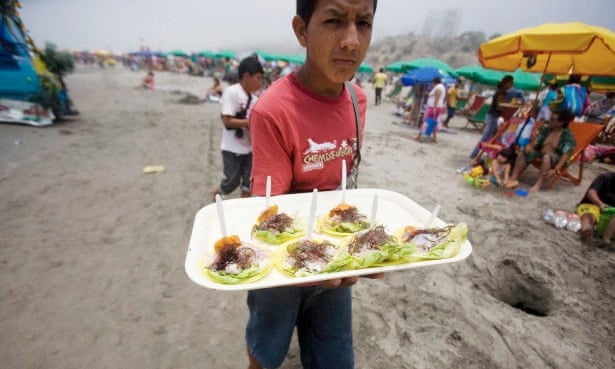
Leche de tigre (tiger’s milk), the citrus-based marinade used in ceviche, Peru’s national dish of raw fish, is said to cure all hangover ills. The name derives from its milky colour and energising properties. Containing lime juice, coriander, chillies, garlic, onion, salt and pepper, the Peruvian elixir can either be drunk as an invigorating aperitif, or poured over a hearty plate of ceviche. The piquant mix of spice and citrus juice is said to levantar muertos, “raise the dead”. With a high concentration of raw herbs and vitamin C, tiger’s milk is also said to be an aphrodisiac. A popular variation that is equally effective for a hangover is leche de pantera, panther’s milk, which uses black clams, lending the marinade a dark hue.
Where to find it in the UK
In London, Peruvian restaurants Andina (1 Redchurch Street, Shoreditch) andCeviche (17 Frith Street, Soho) don’t do the marinade as a drink but both have a selection of ceviches on the menu. Classic ceviche is made from sea bass but alternative versions include beetroot, salmon and scallop (from £5). To really chase away the effects of the night before, wash it down with a superfood smoothie from Andina – try the lucuma (a tropical fruit), kiwicha (a seed grain similar to quinoa), banana and hazelnut concoction called the Chaska.
Kiki Deere
In London, Peruvian restaurants Andina (1 Redchurch Street, Shoreditch) andCeviche (17 Frith Street, Soho) don’t do the marinade as a drink but both have a selection of ceviches on the menu. Classic ceviche is made from sea bass but alternative versions include beetroot, salmon and scallop (from £5). To really chase away the effects of the night before, wash it down with a superfood smoothie from Andina – try the lucuma (a tropical fruit), kiwicha (a seed grain similar to quinoa), banana and hazelnut concoction called the Chaska.
Kiki Deere
Stick to fernet, Argentina
The polite way to describe fernet – a herbal Italian spirit – is as an acquired taste. But get beyond that bitter first sip and, some say, you’ll be spared a nasty hangover. In Argentina, where it’s hugely popular, that belief persists. (You might still suffer if you overdo it, the local lore goes, but you’ll still feel better than a night on any other spirit.) In Buenos Aires, it’s the party drink of choice, mixed with Coca-Cola and on the menu at any one ofthese top bars. In the country’s second city, Córdoba, it’s as common as water. (Try the Fernet Club, Jacinto Rios 126)
San Franciscans are also big fans. Fernet gained a footing in the city after masquerading as medicine to sneak through prohibition. A morning-after shot with a ginger-ale chaser is said to be a miracle cure.
Where to find it in the UK
Fernet is cropping up on more and more cocktail menus, with chef Fergus Henderson singing its praises as an antidote to overindulgence. His Dr Henderson – mixed with an equal quantity of crème de menthe – could be the perfect hair-of-the-dog remedy for the season. Try it at his restaurant, St John in London’s Clerkenwell, or mix it yourself.
Vicky Baker
Fernet is cropping up on more and more cocktail menus, with chef Fergus Henderson singing its praises as an antidote to overindulgence. His Dr Henderson – mixed with an equal quantity of crème de menthe – could be the perfect hair-of-the-dog remedy for the season. Try it at his restaurant, St John in London’s Clerkenwell, or mix it yourself.
Vicky Baker
Haejang soup, South Korea
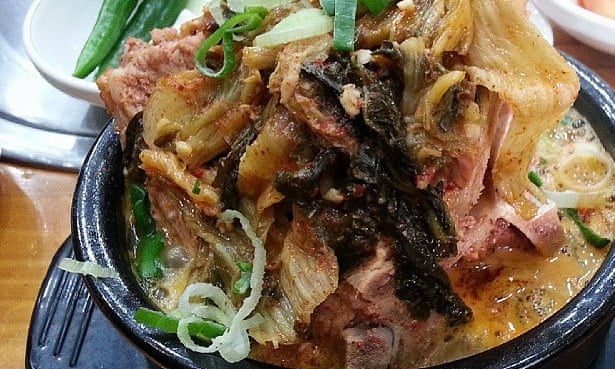
Potent stews for sobering up have ancient roots in Asia, and haejang guk, “soup to chase away a hangover”, is the contemporary Korean cure for one too many sips of soju. Ingredients for the potent stew vary from region to region and kitchen to kitchen, but most are composed of a bone-based broth enriched with napa cabbage, vegetables and congealed ox blood. When pork or beef bones are used, they are simmered until any remaining meat falls off the bone. The piping hot, meaty stew can be accompanied by noodles, rice, or rice cakes. In Seoul, soya-bean paste is often added; other regional variations might use soya beans, radishes and fish.
Where to find it in the UK
New Malden in Surrey is home to the largest population of South Koreans in the UK, making it the place to find authentic Korean cuisine. Su La (79-81 Kingston Road, 020 8336 0121) is one of the best local restaurants, and does a non-meat version of haejang soup.
Katie Parla
New Malden in Surrey is home to the largest population of South Koreans in the UK, making it the place to find authentic Korean cuisine. Su La (79-81 Kingston Road, 020 8336 0121) is one of the best local restaurants, and does a non-meat version of haejang soup.
Katie Parla
Pork bones ‘tea’, Malaysia
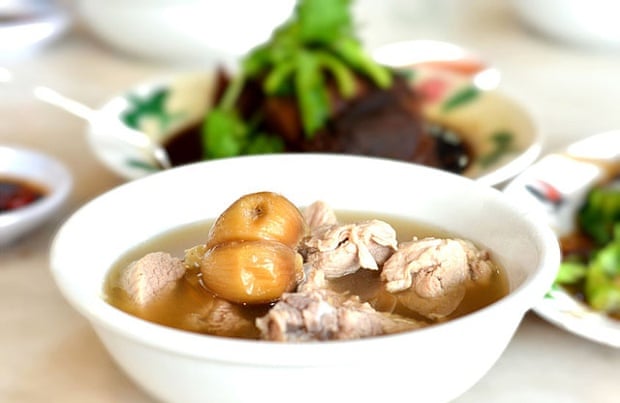
Translated into English, bak kut teh hardly sounds the most appetising cure. Literally “pork bones tea”, it has nothing to do with a good old cuppa, but is actually another delicious, health-restoring Asian broth. Pork ribs are slow-braised in a clay pot for hours with a blend of weird and wonderful Chinese herbs and spices, from star anise, cinnamon, whole bulbs of garlic and ginseng to the invigorating radix astragali, a medicinal dried root. A huge bowl of the rich dark soup is accompanied by deep-fried tofu puffs and a thick, black soy dipping sauce with lethal chopped red chillies. Watch the locals and you’ll see most order a side-dish of pork liver and tripe, too.
It may not have the nightlife profile of Bangkok or Hong Kong, but Kuala Lumpur is a serious party city. Bak kut teh is served late at night through till early morning, and while some prefer to head off a hangover by ordering a bowl before going to bed, others wait till morning and choose their favourite stall for a breakfast pick-me-up. The Sun Hong restaurant (35 Medan Imbi) serves it from 5am to midday.
Where to find it in the UK
In London’s Chinatown, it is served at the no-frills New Fook Lam Moon (10 Gerrard Street, 020 7734 7615). Good equivalents at one of the most popular restaurants in Manchester, Ning, are kari laksa or tom yam soup, both also soothing Asian comfort foods.
John Brunton
In London’s Chinatown, it is served at the no-frills New Fook Lam Moon (10 Gerrard Street, 020 7734 7615). Good equivalents at one of the most popular restaurants in Manchester, Ning, are kari laksa or tom yam soup, both also soothing Asian comfort foods.
John Brunton
Ant tea, Australia
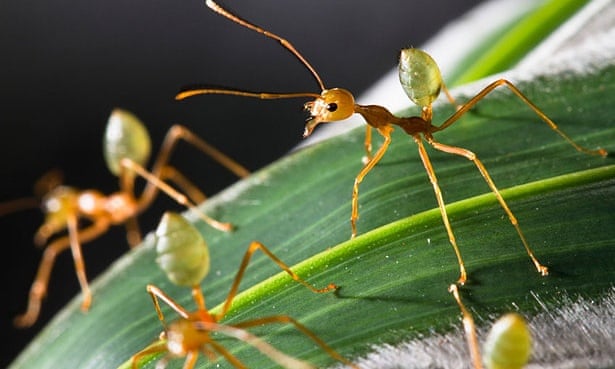
Indigenous Australians have used natural remedies for thousands of years, and green ants have been the traditional go-to insect for headaches and colds, usually taken ground up in a tea – a sort of grub Lemsip. Take a bush walk in Kakadu national park in Australia’s Northern Territory, and your guide may go a bit Crocodile Dundee, plucking a handful from a nest and simply chewing off the bottom half. A dip in the bone-cold Jim Jim Falls plunge pool, reached via a 2km walk through monsoon forest and over boulders, should work wonders, too. There’s also the frisson-inducing possibility of what lurks beneath the surface, though the dangerous “salties” are downstream of here.
Where to find it in the UK
This is a tricky one to recreate back home. “Ants are notoriously hard to rear because of the complex societies they live in, which is why most of the ants eaten in Asia and South America are hunted, not farmed,” says Shami Radia, co-founder of eatgrub.co.uk, which sells edible insects and hosts pop-up insect food “events”. In the absence of ants, go for nutritionally rich crickets (they taste like nutty shrimps) – 69% protein and high in iron and calcium. Alternatively, curl up on the sofa with a cup of tea and a packet of eatgrub’s cricket nut fudge. Mmm.
Lydia Bell
This is a tricky one to recreate back home. “Ants are notoriously hard to rear because of the complex societies they live in, which is why most of the ants eaten in Asia and South America are hunted, not farmed,” says Shami Radia, co-founder of eatgrub.co.uk, which sells edible insects and hosts pop-up insect food “events”. In the absence of ants, go for nutritionally rich crickets (they taste like nutty shrimps) – 69% protein and high in iron and calcium. Alternatively, curl up on the sofa with a cup of tea and a packet of eatgrub’s cricket nut fudge. Mmm.
Lydia Bell
Vodka for breakfast, Mongolia
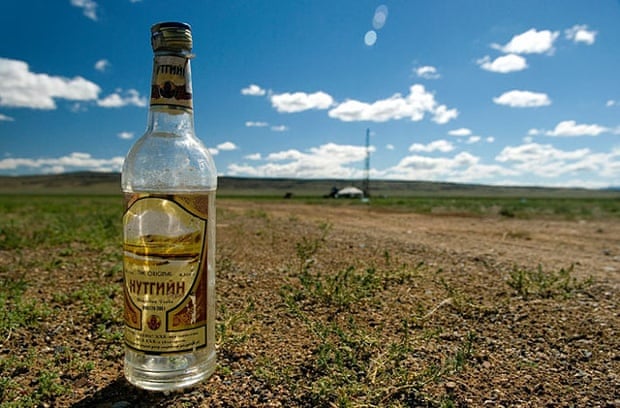
Internet lore mystifyingly claims that Mongolians drink pickled sheep’s eyes in tomato juice as a morning-after treatment. They don’t. While Mongolia’s notoriously mutton-dominated cuisine breathes new life into the concept of nose-to-tail eating, your average patriarch would blanch at anything as plant-based as tomato juice, opting instead for, well, more vodka. Be it the traditional mare’s milk distillate the Chinese call “Mongolian liquor”, or Russian-style vodkas, like Chinggis or Altaï, when it comes to alcohol, the typical rural Mongolian makes Poles, Icelanders and Koreans look like models of sobriety – so whatever is left from the night before is consumed in the morning. A couple of tea bowls of vodka will undoubtedly take the edge off even the gnarliest hangover, albeit only by delaying it until the second day’s alcoholic glow gives way to the ultimate dark night of the soul.
Where to find it in the UK
If you have arrived at the conclusion that you have the constitution of a Mongolian herder, go to Vodka Wodka (Ashton Lane) in Glasgow, which stocks more than 100 brands from 15 countries; Siberia Vodka Bar (Belmont Street) in Aberdeen; or Baltic bar (Blackfriars Road) in Southwark, London (60 varieties including horseradish and basil). Black Cow is a West Dorset-made milk vodka said to be inspired by an old Siberian recipe. It is available across the UK.
Theodora Sutcliffe
If you have arrived at the conclusion that you have the constitution of a Mongolian herder, go to Vodka Wodka (Ashton Lane) in Glasgow, which stocks more than 100 brands from 15 countries; Siberia Vodka Bar (Belmont Street) in Aberdeen; or Baltic bar (Blackfriars Road) in Southwark, London (60 varieties including horseradish and basil). Black Cow is a West Dorset-made milk vodka said to be inspired by an old Siberian recipe. It is available across the UK.
Theodora Sutcliffe
Coffee with a goose egg, Bali
Hangovers are almost de rigueur for tourists in Bali’s Kuta party zone. Yet the women selling hangover cures very rarely attract a foreign customer. Their pick-me-up concoction of strong, sweet coffee, with a heavy dose of condensed milk, might be appealing enough ... but a raw goose egg dropped into it is, apparently, the ingredient that works the magic. There are no cafes selling kopi telur – just look out for the street vendors carrying oversized thermos flasks and a tray of equally oversized eggs.
Where to find it in the UK
Countless exotic treats have taken root in this country, but not kopi telur. For an alternative take on the Balinese hangover cure tuck into a plateful of Soto Ayam Besar, a spiced chicken broth topped with a boiled egg, at Krakatoa in Yorkkrakatoayork.com), then head home to make your own eggy coffee (a hen’s egg is an acceptable substitute). Find the recipe on saveur.com.
Mark Eveleigh
Countless exotic treats have taken root in this country, but not kopi telur. For an alternative take on the Balinese hangover cure tuck into a plateful of Soto Ayam Besar, a spiced chicken broth topped with a boiled egg, at Krakatoa in Yorkkrakatoayork.com), then head home to make your own eggy coffee (a hen’s egg is an acceptable substitute). Find the recipe on saveur.com.
Mark Eveleigh
A meat feast, South Africa
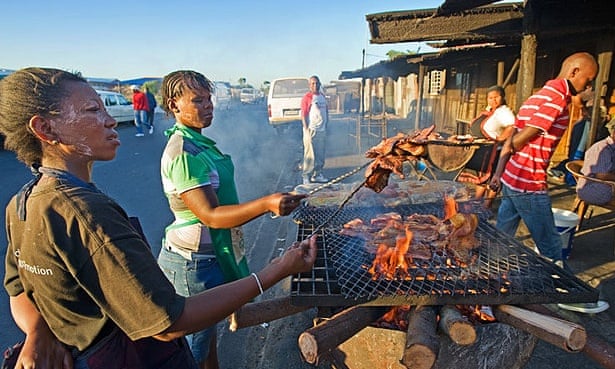
When South Africans complain of a pounding head, chances are they’ll grab a painkiller with one hand and an Underberg, the German herbal tonic with a bitter, medicinal kick, with the other. After that, it’s out with the big guns – a full-fat meat feast, chargrilled over a braai, or barbecue.
For urbanites, the coolest spots to brunch on steak, boerewors sausage and cold beer are township shisa nyama (grilled meat) joints such as Mzoli’s in Gugulethu near Cape Town, Max’s Lifestyle(maxslifestyle.co.za) in Umlazi near Durban, andChaf Pozi (chafpozi.co.za) in Soweto, Johannesburg. Cheap, loud and smoky, they’re great levellers, attracting a mix of locals and “black diamonds”, members of South Africa’s affluent black middle class. You choose some meat at the butcher’s counter and wait for it to be delivered, sizzling, on a wooden board or enamel plate, with pap (maize porridge) and vitamin-rich chakalaka relish on the side.
Cafes in the ostrich-farming town of Oudtshoorn offer vegetarians a satisfying alternative – a huge, healthy, protein-packed ostrich-egg omelette. Just make sure you bring a dozen hungry friends to help polish it off.
Where to find it in the UK
If you want to take this kill-or-cure approach, try Shebeen in Edinburgh, which serves all the boerewors, lamb, steak, pork, oxtail and chicken you could possibly want, plus the South African fast-food favourite, bunny chow, a hollowed-out loaf filled with curry.
Emma Gregg
If you want to take this kill-or-cure approach, try Shebeen in Edinburgh, which serves all the boerewors, lamb, steak, pork, oxtail and chicken you could possibly want, plus the South African fast-food favourite, bunny chow, a hollowed-out loaf filled with curry.
Emma Gregg
Russians swear by pickle juice. Mexicans put their trust in tripe stew. Mongolians, on the other hand, just go for the vodka at breakfast.

沒有留言:
張貼留言